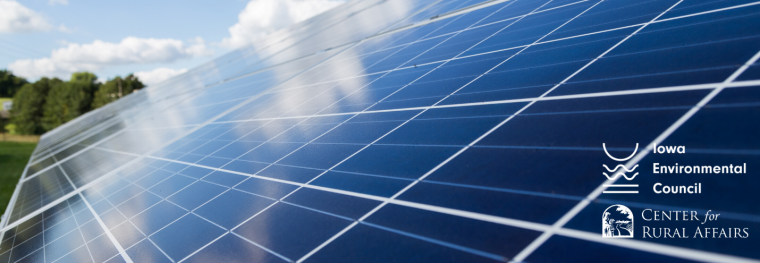
DES MOINES, IOWA (March 5, 2020) — The Iowa Environmental Council and Center for Rural Affairs today announced the publication of a best practices guide for counties developing utility-scale solar-siting ordinances, Iowa Solar Siting Resource Guide: Best Practices for Counties.
“Utility-scale solar and community solar projects are just taking off in Iowa so direct experience here is limited. We want to encourage counties to take a look at best practices for solar siting that are working around the Midwest,” said Jordan Oster, Energy Outreach and Advocacy Coordinator with the Iowa Environmental Council. “Having a good ordinance developed through a public process can provide the certainty necessary to bring the economic benefits of solar to a county while balancing the interests of residents.”
In addition to outlining the best practices of a good solar ordinance including process, treatment in zoning districts, setbacks, infrastructure, and decommissioning, the guide also includes guidance on how to best pair solar with native vegetation and pollinator habitat.
"Pairing solar with native vegetation is a great way to expand the benefits of renewable energy--creating a rural economic development opportunity while providing critical habitat for pollinators and wildlife," said Cody Smith, Policy Associate with the Center for Rural Affairs.
Iowa currently has about 110 MW of solar, mostly located at homes, farms, and businesses. Major utility-scale projects in Louisa, Mitchell, and Howard Counties will bring Iowa’s solar capacity to nearly 1,000 MW with more solar planned in other areas of the state.
“Solar energy can be a source of revenue to counties and farmers while delivering clean, low-cost energy,” said Kerri Johannsen, Energy Program Director with the Iowa Environmental Council. “We hope this guide can be a resource for counties in Iowa to make informed decisions that allow solar to flourish across the state.”
See the solar siting guide at IEC’s website or access it through CFRA.org.
Established in 1973, the Center for Rural Affairs is a private, non-profit organization working to strengthen small businesses, family farms and ranches, and rural communities through action oriented programs addressing social, economic, and environmental issues. Learn more at cfra.org.
The Iowa Environmental Council (IEC) is an alliance of diverse organizations and individuals working together to protect Iowa's natural environment. Founded in 1995, it is the largest and most comprehensive environmental coalition in the state. Through education, advocacy and coalition building, the Council raises awareness, generates action and creates large-scale change that makes Iowa a better place to live, work and explore. Learn more at iaenvironment.org.










